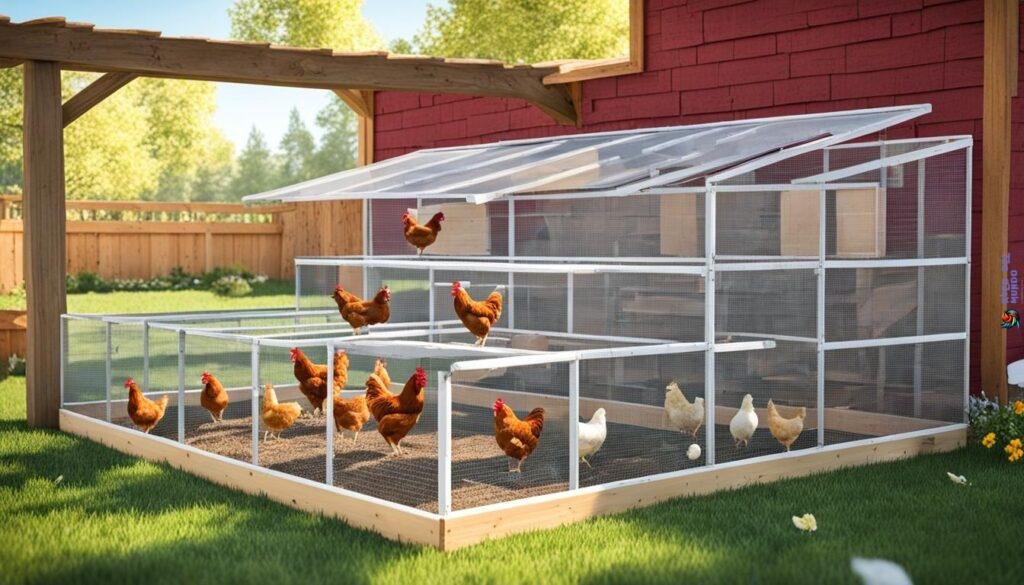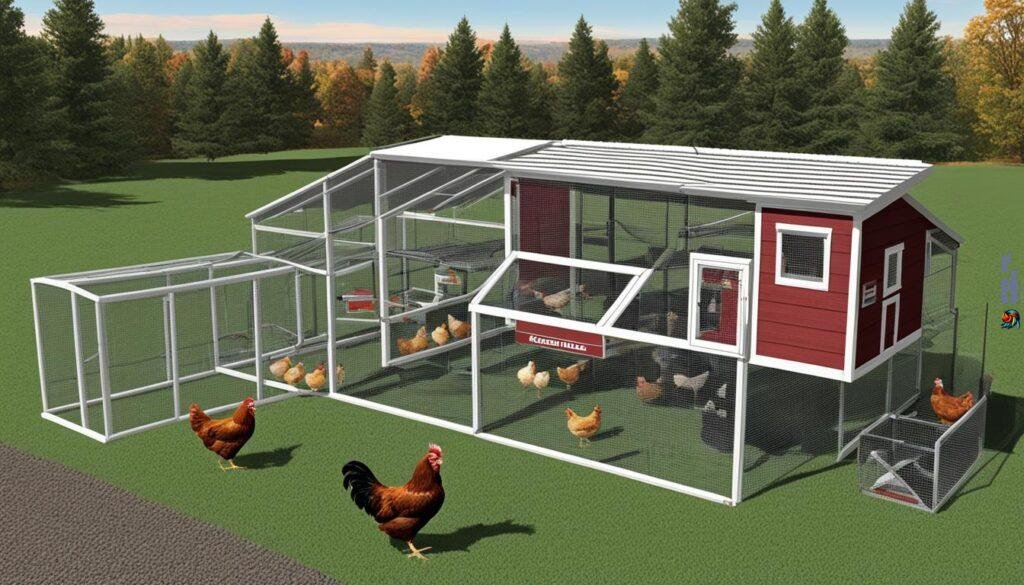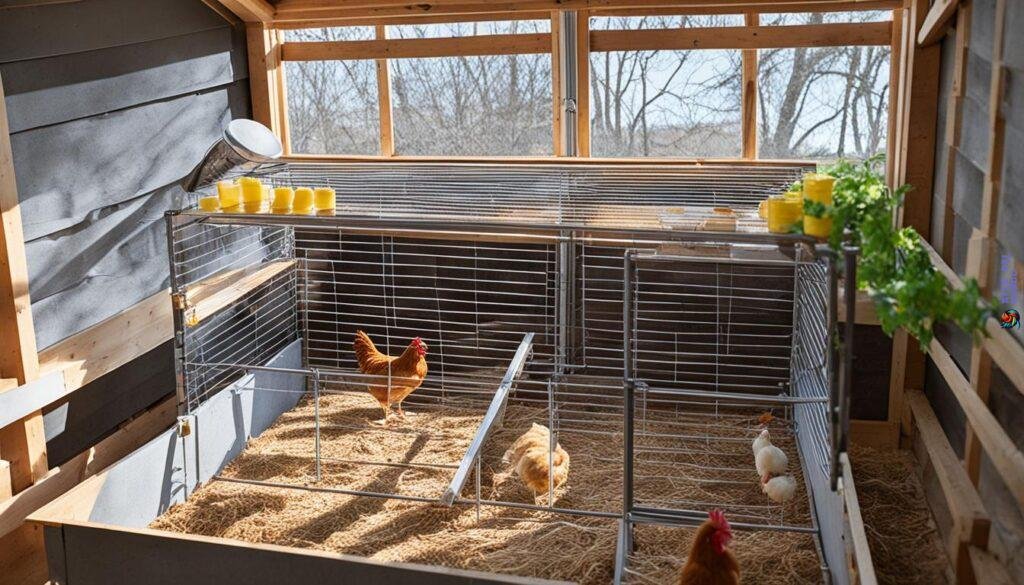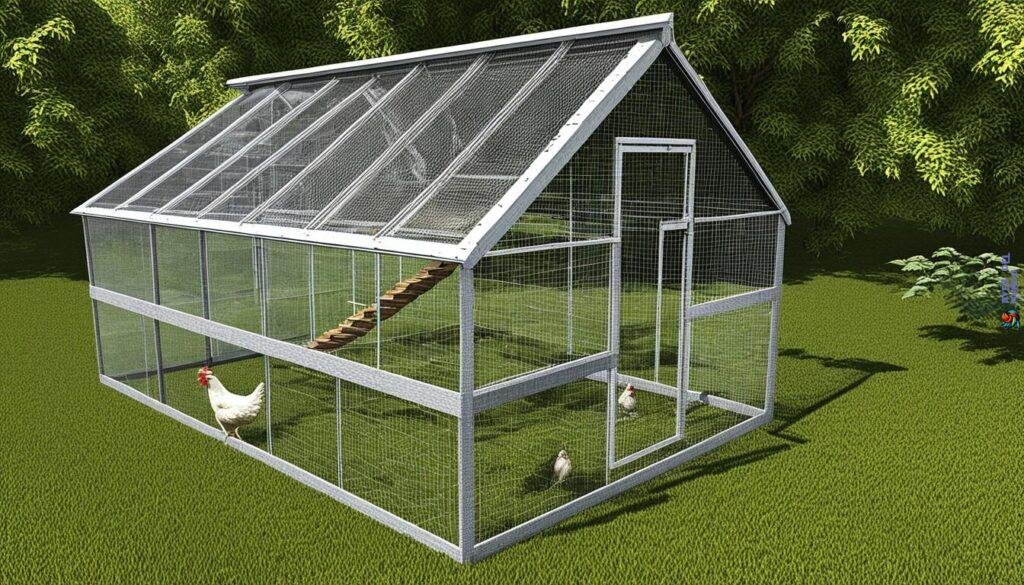Did you know that not managing your chicken coop well can drop egg production by up to 30%? It’s true; having a healthy flock is about more than feed and water. It means knowing how to keep their home just right. This guide is packed with tips to make sure your chickens thrive.
Organizing your coop does more than keep things tidy. It directly affects your chickens’ health and how many eggs they lay. With the right maintenance tips, you’ll learn how to make their home better. This will help them feel good and lay more eggs.
We’re starting a journey to make your coop the best home for your chickens. With smart choices like improving airflow to keeping pests out, we’re creating a haven for your birds. Ready to boost your chickens’ health and egg numbers? Let’s get into the key details of managing your chicken coop right.
Choosing the Optimal Location for Your Chicken Coop
Choosing the right spot for your chicken coop is key. It keeps your flock safe and healthy. Plus, it helps them lay more eggs. A good location considers many important factors.
Avoiding Flooding and Moisture Buildup
Keeping your coop dry is crucial. Put it on higher ground to avoid water getting in. This helps stop bacteria and parasites from growing.
Proximity to Home for Predator Deterrence
Having your coop near your house keeps predators away. Animals like foxes and raccoons avoid human activity. This protects your chickens without you having to watch them all the time.
Maximizing Sunlight Exposure for Egg Laying
Chickens need lots of sunlight for laying eggs. Make sure your coop gets plenty of natural light. This keeps your chickens healthy and helps them lay eggs regularly.

| Elevation | Predator Deterrence | Sunlight Exposure |
|---|---|---|
| High or raised platform | Near human activity | Southern exposure |
| Prevents flooding | Reduces predator risk | Encourages egg laying |
| Minimizes humidity and mud | Enhances flock safety | Requires shade for heat protection |
The Importance of Coop Size and Space Requirements
When you start managing a chicken coop, think about how much room your chickens need. Making sure your chicken coop is big enough is key. If it’s too small, your chickens might get sick or act out.
A small coop can make chickens stressed. Stress affects their health and how many eggs they lay. To avoid stress and fights, use the space guidelines from experts like the University of Georgia.
| Chicken Type | Space with Outdoor Access (sq ft per chicken) | Space without Outdoor Access (sq ft per chicken) |
|---|---|---|
| Standard Breed | 3-4 | 8-10 |
| Bantam Breed | 2 | 5 |
| Heavy Breed | 4-5 | 10-12 |
Use the table above when planning or building your coop. These space numbers help prevent too many chickens in one place. Without enough room, chickens fight over food and water. This makes the coop dirty faster and spreads disease.
The coop’s inside should also be well-planned. It should have nesting boxes for laying eggs and roosting bars for sleeping. Make sure feeders and waterers are placed well so all chickens can eat and drink easily.

Proper chicken coop management is crucial. A good coop design is more than just a nice extra – it’s necessary. It keeps your chickens healthy and productive, which is good for your chicken-raising success.
Proper management of the chicken coop: Materials and Flooring
Starting your journey of chicken coop upkeep guide means picking the right materials is key. Choosing wisely can make your coop last and keep it clean with less work. This means you can care for your coop well without spending too much.
Selecting Durable and Easy-to-Clean Materials
Choosing materials for your coop involves finding a good balance. Plain plywood is strong and cheap, making it a great choice for floors. Adding a layer of linoleum makes cleaning easier and can be replaced if needed, helping your chicken coop upkeep guide.

Benefits of Elevated Coops for Health and Maintenance
Raising your coop has many advantages for caring for your chicken coop. First, it keeps predators away, keeping your chickens safe. It also stops wood rot by keeping the coop away from moisture and pests on the ground. By elevating the coop, you avoid attracting rodents and snakes, making maintenance easier. This setup improves air flow, which is good for your chickens’ health.
Predator-Proofing: Fortification Against Unwanted Guests
To keep your flock safe, a key chicken coop maintenance tip is to strengthen their home against predators. This involves more than hope; it requires careful planning and effort. A secure coop can protect against clever raccoons and strong coyotes and dogs.
Putting your coop off the ground isn’t just for looks. It keeps away many predators that walk on the ground. Adding secure latches too high for raccoons to reach boosts your chicken’s safety greatly.
Remember, if a predator can’t see an immediate way in, it’s less likely to attempt a break-in. It’s like adding a deadbolt to the already sturdy door of your chicken coop.

Choosing the right materials to close off openings is crucial. Opting for sturdy 1/2-inch hardware cloth over chicken wire makes a big difference. Because chicken wire isn’t tough enough to stop biting and clawing predators. Below is a table comparing common materials:
| Material | Effectiveness | Durability |
|---|---|---|
| Chicken Wire | Low – keeps chickens in, but not predators out | Medium – prone to rust and breaking |
| 1/2-Inch Hardware Cloth | High – sturdy barrier against most predators | High – resistant to corrosion and strong |
| Wood Panels | Medium – solid, but can be breached without reinforcement | Varies – depends on wood type and treatment |
In summary, for chicken coop maintenance tips, use a layered defense method. Elevate your coop, use the right latches, and choose solid materials. Your aim isn’t an unbreakable fort, but a coop secure enough to deter predators. This approach offers peace of mind for you and your chickens.
Implementing Effective Coop Ventilation Systems
When you raise backyard chickens, one essential chicken coop care tip is crucial: provide proper airflow. Good airflow is vital for their comfort and health. Plus, it keeps your flock productive.
Ensuring Adequate Airflow to Reduce Disease Risk
Adequate ventilation cuts down the risk of respiratory diseases in chickens. A good system ensures air keeps moving, keeping the coop free of dust, germs, and moisture. Your ventilation should cover at least one-fifth of the wall space. This balance works well in many climates.

The Importance of Positioning Vents Correctly
Where you place the vents matters just as much as their size. Put them near the roof so warm air can escape easily. Make sure the vents are above the roosting area. This prevents drafts from making your chickens cold or stressed.
| Ventilation Feature | Benefits |
|---|---|
| Size of Vents | Prevents the buildup of harmful gases and controls humidity. |
| Positioning Above Roosts | Allows for hot, stale air to escape without creating drafts on the roosting birds. |
| Hardware Cloth Covering | Keeps out predators and pests while enabling air exchange. |
| Adjustable Vents | Provides the ability to control ventilation based on seasonal needs. |
Following these essential chicken coop care tips helps your poultry thrive. Healthy, happy chickens lay more eggs. So, keep your coop well-ventilated for the best results.
Essential Features of Interior Design: Roosts and Nesting Boxes
Making the inside of your chicken coop better is crucial for your birds. The right roosts and nesting boxes make them feel safe and comfortable. These parts of the coop help your chickens act naturally and stay healthy.
Creating Comfortable Sleeping Perches
Chickens like sleeping higher up, away from dangers on the ground. This keeps them warm and safe at night. So, adding strong wooden roosts is a smart move. Just make sure they’re set up higher than the nesting boxes. This stops hens from sleeping where they should be laying eggs.
Designing Dark, Accessible Nesting Areas
Nesting boxes need to be cozy and private for hens to lay eggs. Keeping these areas dark helps hens feel safe and calm. Use straw or sawdust for bedding. It’s soft and keeps eggs safe. Plus, it’s easy to switch out when cleaning.
Think about these details and materials for the best roosts and nesting boxes:
| Feature | Material | Utility |
|---|---|---|
| Roosts | Wood | Higher elevation, night-time comfort |
| Nesting Boxes | Dark, enclosed spaces | Serenity and privacy for egg laying |
| Bedding | Straw or Sawdust | Egg protection, absorbency, easy to clean |
By focusing on these design tips, you make your coop a better place. This leads to a happier and healthier group of chickens. And it means more eggs for you.

Maintaining the Chicken Coop: Cleaning and Upkeep
Knowing how to maintain a chicken coop well is key to keeping your chickens healthy. It’s not all about looks; it’s about your chickens’ well-being. An important step is removing litter beneath roosting areas. It helps control ammonia and keeps the place clean. Also, designing your coop for easy access helps with daily tasks.
Using materials that are easy to clean is smart. For example, newspaper-lined trays absorb well and are simple to change. This keeps the coop clean for your chickens.

- Do a daily check-up: Get rid of old food, refill water, and clean up droppings.
- Each week: Change the bedding in nesting boxes and check for pests or damage.
- Every month: Clean everything, wash and disinfect the coop, and put in fresh bedding.
Let’s detail the cleaning tasks and their schedules:
| Cleaning Task | Daily | Weekly | Monthly | Quarterly |
|---|---|---|---|---|
| Check Water and Food Dispensers | x | |||
| Clear Droppings and Spoiled Bedding | x | x | ||
| Inspect for Pests and Damage | x | x | ||
| Refresh Bedding in Nesting Boxes | x | |||
| Deep Clean and Disinfect | x | |||
| Structural Repair and Maintenance | x |
A clean coop means happy, healthy chickens. Don’t cut corners with coop cleaning. Taking care while learning how to maintain a chicken coop benefits your chickens greatly.
Adding Utilities: Electricity and Lighting Considerations
Managing a chicken coop goes beyond daily care. It includes setting up a well-lit space for the chickens’ health and productivity. Adding electricity can bring big benefits.
Low-Wattage Bulbs for Consistent Egg Production
Good lighting in the coop is crucial for consistent egg production. Using low-wattage bulbs can save energy. They add more light during shorter winter days and help hens lay eggs regularly.

Strategic Placement of Light Sources to Mimic Natural Patterns
The placement of lights in your coop is important. The goal is to mimic natural light, encouraging egg-laying. The light should feel like dawn and dusk to not disrupt the chickens’ rhythms.
Choosing the right steps in coop management means creating a successful environment. It keeps your chickens healthy and productive by blending technology with their natural needs.
Ensuring a Constant Supply of Food and Water
Keeping your chicken coop running well means making sure your chickens always have clean food and water. It’s not just about meeting their basic needs. It’s crucial for their health and egg-laying ability. The feeders and waterers should be placed off the ground. This prevents them from getting dirty with bedding or droppings from the roosting area.
It’s important to refresh food and water every day. This keeps your chickens fed and healthy. By doing this, you avoid diseases and boost egg production. Remember to change the water often to stop algae from growing in warm weather. In the cold, make sure it doesn’t freeze.
Giving your chickens clean and plentiful food and water is key to good coop management. This not only keeps them healthy but also helps them lay more eggs. You might want to think about using automatic feeders and waterers. They make taking care of your coop easier and more effective.



